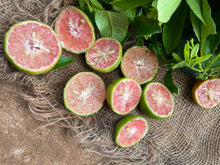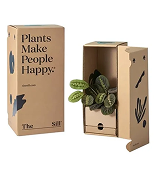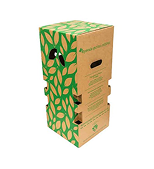- Home
- All Fruit Plants
- Red Lemon - Fruit...
Red Lemon - Fruit Plants





Red Lemon - Fruit Plants




Damaged or lifeless? We’ll replace it for free. Learn more

Double layered custom boxes to protect plants during shipping.

Air vents for proper air-flow

To preserve plant freshness during transit

Details steps of how to grow and maintain your plant
Red lemon is new lemon variety in citrus group. The most amazing part of this fruit plant is it will starts fruiting with in a year after purchasing or sometimes it will delivered to you with fruits on it. The fruit are medium in size, juicy, reddish in color with very less seeds and medium sweet in taste. The plant grow in medium height and does not requires much special care and it can grow in almost all types of soil. The fruiting will be 2-3 times in a year if it is well fertilised and maintained.
Citrus Fruit is used for culinary and non-culinary purposes throughout the world, primarily for its juice, which has both culinary and cleaning uses. The pulp and rind are also used in cooking and baking. The juice of the lemon is about 5% to 6% citric acid with a pH of around 2.2, giving it a sour taste. The distinctive sour taste of lemon juice makes it a key ingredient in drinks and foods also fruit is used in indian traditional medicines also.
Growing Tips
- Citrus species, grow in tropical and subtropical humid regions. pH should be between 5.5 and 6.5. If acidity is high, it is necessary to apply lime to achieve the optimum level.
- Easy to grow even in pot/direct soil wherever direct sunlight are available. Soon after planting, plants should be supported with bamboo stick and irrigated thoroughly.
- While planting care should be taken to see that the bud-joint should always be above the ground level.
- Temperature ranging from 15-35℃ is suitable for cultivation of the crop.
- The bearing trees require little or no pruning. All diseased, injured and drooping branches and dead wood are to be removed periodically.
- Citrus Variety requires consistent watering to produce healthy fruits. Giving it too much or too little water can lead to blossom and fruit drop and sometimes plant may die too.
- Check top 2-inch layer of soil for dryness before watering. On windy and hot days, it requires more frequent watering.
- Micro-nutrients (zinc, copper, manganese, iron, boron and molybdenum) are required in ample quantities. It should be supplied through foliar spray.
- Application of organic mulch surround the basin, improves the fruit quality and maintain moist environment.
- Fruit drop in citrus can be controlled in early stages of fruit development by applying two sprays of growth regulators- 2,4 D (15 ppm.) or GA3 (15 ppm) along with Benomyl (1000 ppm.) and urea (1%) at the time of flowering and after the fruit set.
- Never prune the plants during monsoon and wet climates.
TEMPERATURE - Between 15-35 Degree Celsius.
MAXIMUM HEIGHT - It can reach upto 5 meter (if planted in ground)
BLOOMING TIME - Flowering 2 times in a year(spring & rainy)
FRUITING TIME - It starts fruiting after 1.5-2 yrs after planting. Major fruiting month are (July/September/November/January)
Fertilizer - Organic Fertilizer once in 3 month.
INSIDE THE BOX
| S.No. | PRODUCT NAME | DIMENSION |
| 1. | Lemon Plant | 1-2 Feet Height |
| 2. | Growing Pot (Black color) | 6 Inch |
**above specifications are for indicative purpose only, actual dimensions may slightly vary.
INITIAL CARE FOR 10-15 DAYS JUST AFTER RECEIVING YOUR PLANT
- Remove the Packaging Materials carefully.
- Press the soil in the pot & add additional soil(garden mix) if necessary.
- Maintain moisture in the pot, Do not over water it may kill your plant, so make sure that the soil should be dry between watering.
- Make sure that plants get enough morning direct bright light(2-3hrs) for 10-15 days & do not go for immediate transplanting (minimum 1 month)
- After 1 month you can transplant it into slightly bigger pot than the present pot or directly in the ground.
- Just prune if any branch of the plant is get damaged in transits. New leaves will come definitely.
Selected plant of 8-10 inches
Planted into a 5-inch pot
With healthy, moisture-retaining soil
A care instruction sheet for maintenance guide

Get in touch for best pricing on bulk orders and landscaping projects.
 WhatsApp us
WhatsApp us

Call on 9177805454 (Mon-Sat, 9 AM-6 PM) or WhatsApp us – we’re here to help.
About Exotic Flora
At Exotic Flora, we’re passionate about bridging the gap in bringing plants to everyone. With over 500+ varieties across 7 plant categories, from exotic finds to everyday greens, we bring the entire range to you.
Our plants, sourced from all parts of India are nurtured at Kadiyam, in our 25 acres in-house nursery by a team of expert horticulturists. Once they are ready we ship all our plant varieties across India.
Our services go beyond safe delivery of plants. A dedicated support team is there to help you with any maintenance queries you may have.
At Exotic Flora we always believe in going that extra mile, because everyone should have the plants they love.
Every, fruit plants vary in their fruiting time, depends on location, climate & age of the plants. Generally, Grafted fruit plants starts fruiting within 2 years of planting, where as non-grafted plants take more than 2 years. You can check the fruiting time of each plant in the plant description.
No, Majority of fruit plants are not delivered with fruits. But some grafted fruit plants can be delivered with fruits and flowers mostly Citrus, Guava, Star fruit, Fig, Ber etc. But it is recommended to remove the flowers during early days, so that plants can get more branches and physical strength.
Grafting is a technique where two plants part are combined together so that they can grow together. Most commonly seen in Mango. Air Layering is also a vegetative propagation technique where a plant is produced while it is still attached to its parent's plants. Commonly seen in Guava. Stem cutting is a vegetative propagation technique, where soft, semi-hard, or hardwood stem is cut with 2-3 nodes and used for the multiplication of plants. Commonly seen in flowering & ornamental plants.
Yes, the grafted fruit trees produce fruit earlier, than the non-grafted fruit plants.
These are some of the rare and new fruit plants and it's varities, which are not avialable everywhere in our country.
Remove the plant from its pot. Make sure to not disturb the root ball. Place the plant in a prepared pit(1x1ft) or slightly bigger pot than the current pot. Firm the soil around the plant with your hands. Water well till it drains out from the drainage hole.
In order to maintain the good shape of the plants, proper care should be taken from the beginning like the pruning of unwanted and diseased parts of plants, stalking to young plants, regular maintenance of plants.
In General, a grafted/air layered/hybrid fruit takes 2 years for fruiting, whereas seeded grown plants take 4-5 years of time for fruiting. But it may vary depending on the plant types.
In general if your soil weell drained, fertile and organic in nature, it will produce good quality fruit. Sandy-loamy is the most preferable soil used for fruit plants.
Size and taste of each fruit plants varies depending on the varieties. You can find more details about each fruit plants in terms of size and taste in the description of individual plants.
Initial first 2 years are very important to feed the plants with organic manure and fertilizers regularly. It is recommended to add organic manure or compost to each plant in every 3 months of time intervals. Do not go for Chemical fertilizers it will weaken the plants in future.
Plastic pots with drainage holes preferably work best as they are lighter to move around. Any other container which is light in weight with a drainage hole can also work to grow fruit plants.
I really Appreciate the way your team dedicated for excellent packing and super safe delivery near about Plants travelled 1000 km.
